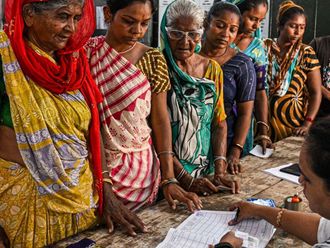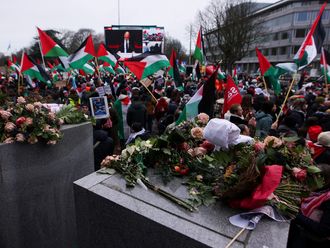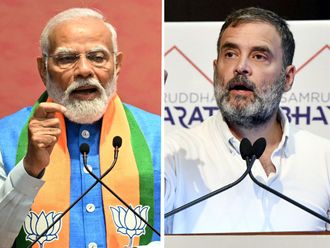Considering the exacting toll 2014 took on the Arab states and societies, there is no doubt that 2014, as I argued in my columns a year ago, will go down in the history of the Arab world as the worst year in living memory. That was also the sober and realistic assessment of Arab League Secretary General Nabeel Al Arabi, who pointed out that 2014 was the worst year for the Arab world. In 2014, the Arab world seemed to crack at the seams. In two columns in Gulf News at the beginning of 2014, I argued that “2013 was by and large a depressing year because the US abdicated its leadership role and became inward looking, wavering and indifferent over many issues. Mayhem, chaos and indecisiveness marked 2013 as it gave way to 2014. Actually, the US role — or lack thereof — made things worse in our region.”
I ended that column by saying: “It will be interesting to follow and monitor these events and developments (in 2014) to see how these events play out at both the regional and international landscapes, where much of these phenomena and developments need to be addressed and come to fruition.
“In 2014, many crises will come home to roost. Syria, Egypt, Iraq, Iran, the GCC states, Libya, Lebanon, Yemen and the Arab-Israeli peace process will present challenges that need to be tackled and contained, so our region won’t unravel. But the worrying trend is the fear of more fragmentation along sectarian lines, the rise of radicalism and the resurgence of Al Qaida and its affiliates like Daesh (Islamic State of Iraq and the Levant). Judging from the first three weeks of 2014, things do not look good. It is clear the events will continue to deteriorate. Given these grim and depressing crises, optimism is in short supply.”
Having made those ominous and depressing predictions, back in January 2014, I am dismayed to point out that many of my predictions came to pass; 2014, was indeed a depressing and pivotal year, where the escalating trend was mayhem and disorder. And the almost century-old Sykes-Picot colonial design started to unravel.
Everywhere we looked in the Arab world during 2014, there were terrible stories. The faltering peace process between the Israel and the Palestinians; and Tel Aviv’s brutal war during the summer against Gaza convinced many of the bankrupt US policy in the region. The year ended with the US vetoing an Arab-sponsored resolution at the UN Security Council to set a deadline of 2017 to end Israel’s illegal occupation of Palestine. It is ironic that the US insulted all Arabs and Muslims and vetoed its own vision for a two-state solution.
Although, there were many elections for presidents and parliaments in many Arab republics, none of them nudged any country onto a democratic path, perhaps with the exception of Tunisia. But it was not enough to end the Arab Spring and its short-lived, false aspirations. The sectarian cleavages and the fight within Islam between the majority Sunnis and minority Shiites exacerbated the already charged and tense societal and political tensions. This was exploited by Islamist hardliners, both Sunnis and Shiites.
The highlight of 2014 was the resurgence of terrorism and the return of a reluctant and retrenched US to the Middle East. The emergence of Daesh and other terrorist groups was the highlight of the year. Daesh swept across Syria and captured Mosul, the second largest city in Iraq. And the declaration of the ‘caliphate’ was an earth shattering development in 2014. The gruesome practices of Daesh — subjecting people to their harsh misinterpretation of Islamic law, beheading American journalists and British aid workers, fighting fiercely three Arab armies in Iraq, Syria and Lebanon —wooed bewildered recruits and forced the US to return hesitantly to a region it had abandoned. America then led a 50-nation coalition of the willing to fight this dangerous non-state actor in Iraq and Syria. That was the highlight of 2014. After over $1 billion(Dh3.67 billion) spent on the campaign, and the forcing out of the US secretary of defence Chuck Hagel, Daesh is still menacing, alive and kicking. It may have been weakened, slowed down, and degraded, but it has by no means been defeated.
The central governments in the Arab republics were weakened and witnessed a continued downward spiral into chaos and mayhem. That was evident in Libya where various Islamist militias roam the cities and enforce their laws and engage in attacks against the retired General Khalifa Haftar. It is also evident in Yemen, where the Al Houthis supported by Iran are active. In 2014, the Syrian debacle reached epic proportions of insanity.
Last year was one of the bloodiest in Iraq, Syria, Palestine, Libya and Yemen. About 15,000 Iraqis were killed and half a million were displaced due to violence and war. Hundreds of thousands were forced to leave their dwellings as a result of their sectarian affiliation.
Syria continued to bleed and to suck the whole region into the abyss. The latest figures show that over 76,000 Syrians were killed in 2014 — that made this the bloodiest year in almost four years of the Syrian tragedy. The absurdity of the Syrian situation was highlighted when Bashar Al Assad staged a sham election and ‘won’ a third-term in power by 10 million votes; the other 10 million Syrians lay dead, injured or displaced. Clearly, in 2014, in Syria, Iraq, Libya, Lebanon and Yemen, the nation state system was upstaged by non-state actors.
In 2015, there is little hope that the vexing crises in the region will ease or go away. Unfortunately, we can expect more of the same. Nevertheless, and against all odds, I wish everyone a happy and prosperous 2015!
Professor Abdullah Al Shayji is the former chairman of the Political Science Department, Kuwait University. He is currently a Visiting Scholar at the Middle East Centre in George Washington University. You can follow him on Twitter at www.twitter.com/@docshayji












